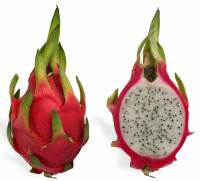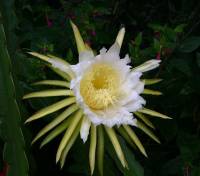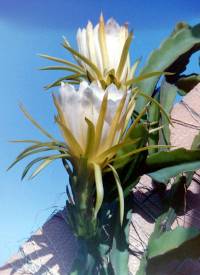Hylocereus undatus is lithophytic or hemiepiphytic. It is widely distributed through the tropics in cultivation. Like all true cacti, the genus originates in the Americas, but the precise origin of the species H. undatus is uncertain and it may be a hybrid. Hylocereus undatus is a sprawling or vining, terrestrial or epiphytic cactus. They climb by use of aerial roots and can reach a height 10 meters or more growing on rocks and trees. The genus is very variable and closely related to Selenicereus. Dragonfruit stems are scandent (climbing habit), creeping, sprawling or clambering, and branch profusely. There can be 4-7 of them, between 5 and 10 m or longer, with joints from 30–120 cm or longer, and 10–12 cm thick; with generally three ribs; margins are corneous (horn-like) with age, and undulate. Areoles, that is, the small area bearing spines or hairs on a cactus, are 2 mm across with internodes 1–4 cm. Spines on the adult branches are 1-3, 2–4 mm long, being acicular (needle-like) to almost conical, and grayish brown to black in colour and spreading, with a deep green epidermis. The scented, nocturnal flowers are 25–30 cm long, 15–17 cm wide with the pericarpel 2.5–5 cm long, about 2.5 cm thick, bracteoles ovate, acute, to 2.5 to less than 4 cm long; receptacle about 3 cm thick, bracteoles are linear-lanceolate, 3–8 cm long; outer tepals lanceolate-linear to linear, acuminate (tapering to a point), being 10–15 cm long, 10–15 mm wide and mucronate (ending in a short sharp point). Their colour is greenish-yellow or whitish, rarely rose-tinged; inner tepals are lanceolate (tapering to a point at the tip) to oblanceolate (i.e. more pointed at the base), up to 10–15 cm long about 40 mm wide at widest point, and mucronate, unbroken, sharp to acuminate (pointed), and white. Stamens 5–10 cm long, are declinate, inserted in one continuous zone from throat to 35 mm above the pericarpel and cream. The style (bearing the stigma) to 17, they are 5-24.5 cm long, stout, 6–8 mm thick, cream, and up to 26 stigma lobes, they can be whole or sometimes split at the top, cream, about 25 mm long. Nectar chambers are 30 mm long. The fruit is oblong to oval, 6–12 cm long, 4–9 cm thick, red with large bracteoles, with white pulp and edible black seeds.


